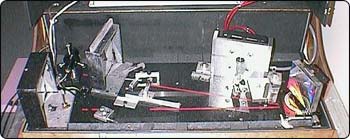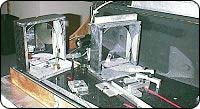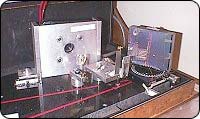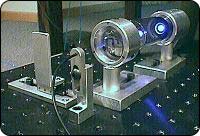 (Click on many of the graphics to see full-size images)
(Click on many of the graphics to see full-size images)
This is a thermally and mechanically stabilized spectrograph purpose built for measuring stellar velocity. It is capable of measuring shifts in the spectrum of one millionth of an inch. This is the general layout. The system is a typical Czerny-Turner two-mirror setup with the lower left mirror acting as the collimator and the upper left mirror focusing the spectra into the CCD.
 The spectrograph is housed in a thermally-controlled wooden box inside an outer foam box. The CCD camera is left on continuously to stabilize the temperature. The ambient and chassis temperatures are monitored by thermocouples that are recorded every 5 seconds and graphed in Labview. Temperature typically stays within 1 degree and the spectra drifts less than 3 tenths of a 24 micron pixel. This is one of the big advantages of a fiber spectrograph and allows the instrument to be placed in a favorable environment.
The spectrograph is housed in a thermally-controlled wooden box inside an outer foam box. The CCD camera is left on continuously to stabilize the temperature. The ambient and chassis temperatures are monitored by thermocouples that are recorded every 5 seconds and graphed in Labview. Temperature typically stays within 1 degree and the spectra drifts less than 3 tenths of a 24 micron pixel. This is one of the big advantages of a fiber spectrograph and allows the instrument to be placed in a favorable environment.
 The spectrograph chassis is an 18"x36" black granite slab drilled for threaded inserts at strategic locations. The mirrors are mounted on the left, the diffraction grating on the lower right, and the CCD is on the upper right.
The spectrograph chassis is an 18"x36" black granite slab drilled for threaded inserts at strategic locations. The mirrors are mounted on the left, the diffraction grating on the lower right, and the CCD is on the upper right.
 This is a close up of the 6" diameter parabolic mirrors. The collimator mirror on the left has a 30" FL and the camera mirror has an 18" FL. The mirrors are mounted in granite holders for identical thermal expansion with the base.
This is a close up of the 6" diameter parabolic mirrors. The collimator mirror on the left has a 30" FL and the camera mirror has an 18" FL. The mirrors are mounted in granite holders for identical thermal expansion with the base.
 The diffraction grating is mounted on a rotary stage and is held in place by a fully adjustable mount. The incoming fibers are mounted on the central vane in front of the grating.
The diffraction grating is mounted on a rotary stage and is held in place by a fully adjustable mount. The incoming fibers are mounted on the central vane in front of the grating.
> This is the Thorium Argon lamp used as a reference source. Two additional fibers feed this light into the spectrograph and superimpose reference lines above and below the spectrum.
This is the Thorium Argon lamp used as a reference source. Two additional fibers feed this light into the spectrograph and superimpose reference lines above and below the spectrum.
 The 100' fiber cable that runs between the telescope and the spectrograph is actually seven fibers contained in a Teflon-lined bicycle brake cable. Each fiber is 120 microns (or about two human hairs) wide. They are arranged in a circular pattern with the main fiber in the center. Once inside the spectrograph, the seven telescope fibers are joined by two more fibers from the reference lamp. Both fiber ends are polished under a microscope to a mirror finish
The 100' fiber cable that runs between the telescope and the spectrograph is actually seven fibers contained in a Teflon-lined bicycle brake cable. Each fiber is 120 microns (or about two human hairs) wide. They are arranged in a circular pattern with the main fiber in the center. Once inside the spectrograph, the seven telescope fibers are joined by two more fibers from the reference lamp. Both fiber ends are polished under a microscope to a mirror finish


In these two pictures you can clearly see the seven fiber apertures coming in from the telescope. Only the #3 fiber is used for star imaging; the rest are for alignment.
Specifications:
AP7b CCD 512x512 pixels 24 micron square.
Grating 1800 line blazed to 500 nm
Dispersion with 1800 line grating .14 ang / pixel
Spectroscopic resolution:
R = 7,000
Temperature control = 1 deg.
Pixel drift per night < 0.1 pixel
Error = +- 200 m/s
Light gathering ability, 16" scope = 4.5 mag. star, 700 sec. exposure = 3000 counts or 9000 photons per pixel.